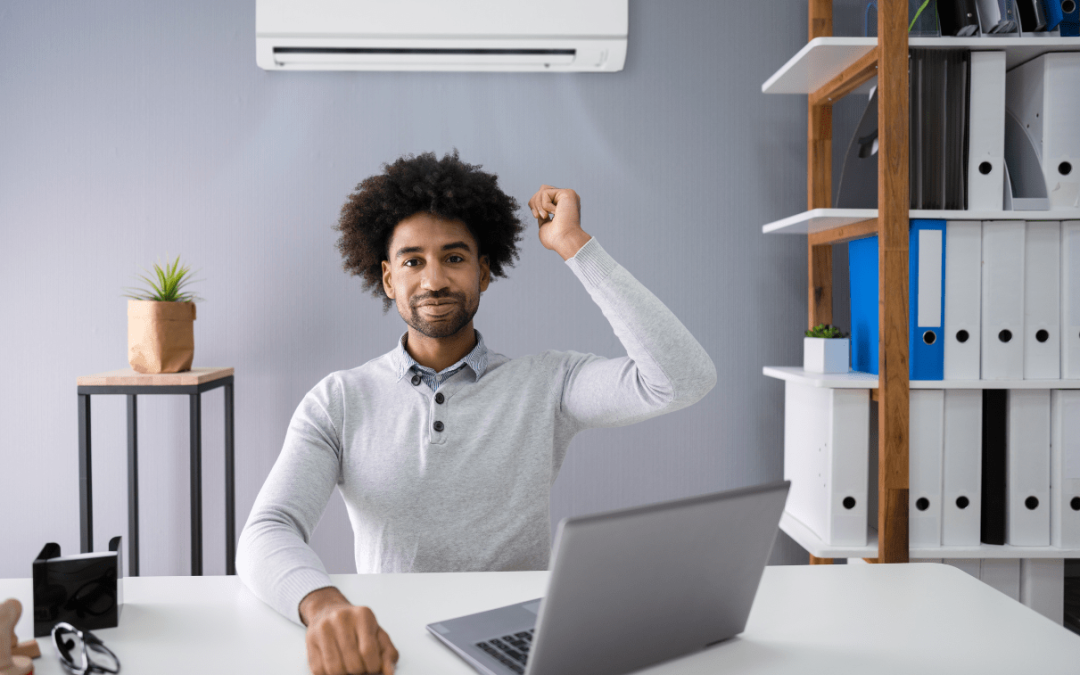Smart temperature settings:
Setting smart temperature settings is one of the easiest and most efficient techniques to improve the office’s air conditioning efficiency. The perfect temperature range for most office areas is 72°F to 76°F, or 22°C to 24°C. However, everyone has different comfort preferences.
Scheduled modifications made possible by programmable thermostats allow the system to run at reduced capacities during non-peak hours, conserving energy. It may also be helpful to encourage staff to dress seasonally so that drastic temperature changes aren’t necessary. In addition to helping with energy efficiency, this little change will make the office a greener place to work.
Regular HVAC maintenance:
Heating, ventilation, and air conditioning (HVAC) systems that are regularly serviced run more efficiently, which in turn reduces energy consumption and increases equipment lifespan. Cleaning or changing the air filter, checking the ducts for leaks, and making sure all parts are in good shape are all part of regular maintenance.
Preventing unexpected breakdowns and expensive repairs is possible with regularly scheduled professional inspections that can detect problems before they worsen. In addition to reducing energy costs, workplaces may keep their indoor environments constant and comfortable for workers by investing in preventive maintenance.
Zone cooling systems:
One strategic method to meet the needs of different regions with different temperature preferences is to set up zone cooling systems. Zoning enables precise temperature regulation in response to occupancy and use patterns. Personal temperature controls allow for the optimization of comfort levels and the reduction of overall energy usage in open workplaces, conference rooms, and break areas.
To facilitate real-time data-driven adjustments, zoning features are commonly included in modern building management systems. Energy savings are just one benefit of this method, which also gives workers greater freedom to make their surrounding spaces seem more like home.
Natural ventilation and lighting:
Reducing the need for air conditioning in the workplace is as simple as installing windows and openings to let in more natural light and air. You may improve airflow and reduce the need for continuous cooling by making use of ventilation systems, skylights, and windows. To create a healthier indoor environment, it is recommended to open the windows when the weather permits.
Another way to reduce the amount of direct sunlight that enters the office is to strategically position shade items like blinds or drapes. Not only does this blend of natural materials save energy consumption, but it also helps create a greener and more sustainable workplace.
Employee awareness and training:
The effectiveness of any strategy depends on raising staff awareness and providing them with the training they need to conserve energy and use the air conditioner efficiently. Make sure your employees know how their daily activities affect energy usage by holding frequent training sessions. Motivate people to do things like switch off electronics when they’re not in use, report HVAC problems quickly, and adhere to established temperature control protocols.
A more sustainable work environment can be achieved by encouraging employees to take personal responsibility through group efforts to reduce energy consumption. To further encourage employees to embrace eco-friendly habits, it may be worthwhile to acknowledge and award groups or individuals who make significant contributions to energy conservation efforts.
Energy-efficient equipment:
A major investment that provides long-term savings is replacing inefficient HVAC systems with more energy-efficient ones. Modern features, higher energy efficiency ratings, and enhanced temperature control capabilities are common in newer versions. Important signs of efficient equipment are high seasonal energy efficiency ratio (SEER) scores for air conditioning units.
It may seem like a lot of money initially, but you can end up saving money on your energy bills. Keep up with the latest energy-saving technology by checking for updates regularly and, if possible, retrofitting or replacing the HVAC system.
Remote temperature monitoring:
Remote temperature monitoring systems are now possible thanks to technological advancements. In addition to making HVAC system management easier, this also allows for quicker responses to temperature changes or unforeseen problems.
Offices with fluctuating occupancy levels or those with different spots can greatly benefit from remote monitoring. A more flexible and responsive air conditioning approach is achieved by preventing energy from being wasted on cooling empty spaces and by allowing adjustments based on specific demands.
Thermal insulation:
Having good thermal insulation is essential for a constant temperature inside. Homeowners can lessen the strain on their HVAC systems by insulating their walls, ceilings, and floors. This helps to retain cooler air during the summer and warmer air during the winter. Find out where the office needs more insulation by doing a comprehensive examination.
Improving energy efficiency and making the interior more comfortable and stable are two outcomes of addressing insulation difficulties. Insulation is an investment that pays off in the long run by reducing the frequency and the degree of air conditioning system modifications, which in turn reduces energy consumption.
Assessing air quality regularly:
Keeping the interior air quality high is just as important as controlling the temperature when it comes to efficient air conditioning. By doing air quality checks regularly, problems like mold, dust, and pollutants that could impact the efficiency of the HVAC system can be caught in time.
The air conditioning system will run at its best and the workplace will be healthier as a result of improved air quality. Investing in ventilation systems or air purifiers can help improve the air quality indoors. Cleaner air, in addition to a pleasant temperature, helps employees avoid respiratory problems and improves their health in general.


